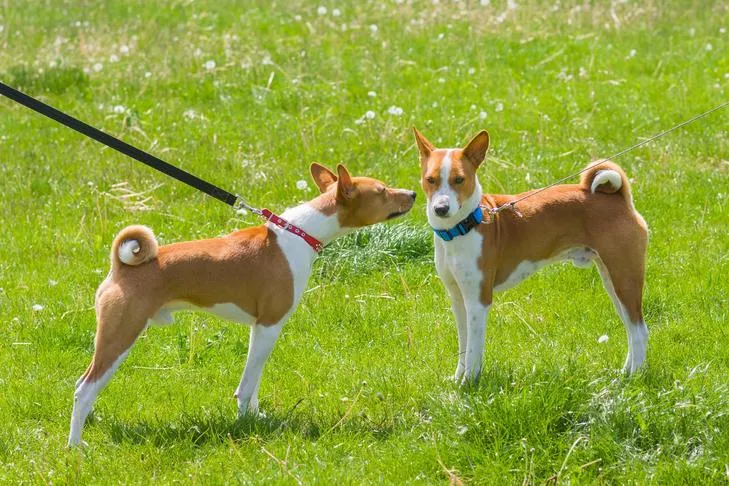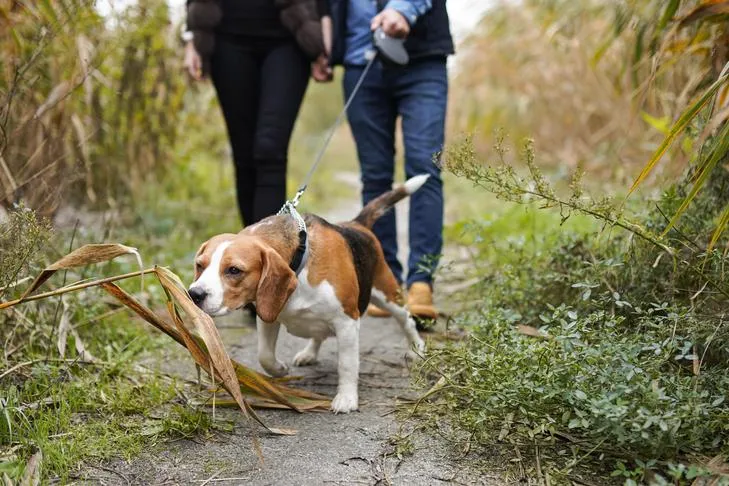Walking your dog should be an enjoyable experience for both of you, a chance to explore the world together. However, for many dog owners, the simple act of a daily walk can become a strenuous struggle against a pulling dog. Not only is it legally mandated in most public areas to keep your dog on a leash, ensuring their safety and the safety of others, but a dog that constantly pulls can lead to discomfort, frustration, and even injuries for the handler. If you’re wondering How To Get Your Dog To Not Pull on the leash, you’re not alone. This common issue can be resolved with consistent training and adjusting your approach to walks.
Nobody wants to be dragged down the street, especially with a larger dog, where strong pulling can cause serious physical strain. The good news is that teaching your dog appropriate leash behavior is entirely possible with simple techniques and a commitment to positive reinforcement. By understanding why dogs pull and implementing effective training strategies, you and your furry friend will soon be enjoying peaceful, collaborative walks. Follow these 10 practical tips to transform your walks from a tug-of-war into a harmonious stroll. For more general guidance on improving your dog’s walking manners, consider exploring resources on how to train a dog to walk nicely.
1. Always Reward Good Leash Behavior
Never underestimate the power of positive reinforcement when it comes to dog training. Dogs are more likely to repeat behaviors that are rewarded, whether that reward comes in the form of a tasty treat, verbal praise, or the opportunity to engage with their environment, like sniffing a particularly interesting spot. If you only pay attention to your dog when they’re doing something wrong and take polite behavior for granted, they’ll quickly learn that misbehavior is a more effective way to get your attention or what they want.
Whenever your dog is walking calmly by your side with a loose leash, make sure to reinforce that desirable behavior. Carry treats with you on walks, or be ready with gentle pets and enthusiastic praise. Don’t be shy about rewarding them generously in the beginning. Let your dog know you appreciate their effort. As your dog’s loose-leash walking skills improve, you can gradually reduce the frequency of food rewards and substitute them with “life rewards,” such as a moment to sniff a tree trunk or a quick, calm greeting with another dog (if appropriate).
2. Never Let Your Dog Walk When They Are Pulling
The primary reason dogs pull on the leash is because they want to move forward and explore. If you allow them to continue walking while they are pulling, you are inadvertently rewarding the very behavior you want to stop. Dogs repeat behaviors that earn them rewards, so letting them pull will only reinforce and worsen the habit in the long run.
Therefore, the golden rule is: never walk when your dog is pulling on the leash. The moment you feel tension on the leash from your dog pulling, stop immediately. Plant your feet firmly and wait. Do not move forward until the leash goes slack and your dog either returns to you or shifts their attention, releasing the tension. This teaches your dog that pulling makes the walk stop, while a relaxed leash allows it to continue.
 Basenji dogs greeting each other in a grassy field, one politely on leash during a training walk.
Basenji dogs greeting each other in a grassy field, one politely on leash during a training walk.
3. Wait for a Loose Leash Before You Walk
If stopping when your dog pulls is the first step, knowing when to resume walking is equally crucial. The key is to wait for a truly slack leash – it should form a “J” shape or be completely loose. Your dog should also ideally turn their attention back to you, even for a moment. This might take some patience, especially in the initial stages of training, as your dog tries to figure out why the walk has paused.
Eventually, your dog will look back or walk towards you to see what’s holding things up. At that precise moment, offer immediate praise and a treat positioned at your side, then calmly resume walking. You might find yourself stopping and starting every few steps at first, but your dog will quickly learn the connection: pulling stops the fun, while walking politely keeps the adventure going. This systematic approach is fundamental to how to train a dog from pulling when walking.
4. Incorporate Life Rewards on Your Walk
A walk should be a stimulating and enriching experience for your dog, offering more than just a bathroom break. It’s an opportunity for both physical exercise and crucial mental stimulation. When you’re actively working on teaching your dog not to pull, it can sometimes feel like these enriching elements are put on hold. However, you can enhance both training and enjoyment by integrating “life rewards” into your walks.
Life rewards are simply the everyday pleasures your dog enjoys, such as the chance to sniff a specific bush, investigate a new smell, or greet a friendly stranger (with permission). For example, if your dog walks politely for a set distance, say 10 feet, release them to sniff a patch of grass for a few minutes as a reward. These bonus rewards powerfully reinforce the idea that good leash manners truly pay off, making the walk more enjoyable for them and easier for you.
5. Walk at a Good Pace
Often, human walking paces are far too slow for dogs. Even small breeds, despite their short legs, often prefer to move faster than their human companions. This difference in pace is a significant reason why dogs tend to pull – they simply want to get moving and cover ground more quickly.
To help your dog feel more engaged and less inclined to pull, try to choose a walking pace that is comfortable and brisk for both of you. While you can certainly teach your dog to match your speed eventually, during the initial training phase, a quicker, more purposeful pace can actually make it easier for them to learn not to pull. It helps them expend energy and feel like they are accomplishing something, making them less likely to forge ahead.
6. Be Consistent With Your No-Pulling Rule
Consistency is paramount in all aspects of dog training, and especially when addressing leash pulling. It can be incredibly tempting to let your dog pull when you’re in a hurry – perhaps you’re running late, or the weather is unpleasant, and you just want to get their potty break over with. However, every time you allow your dog to pull on the leash, you effectively undo all the progress you’ve made, setting your training back to square one.
Regardless of the situation, you must be unwavering with your no-pulling rule. Until your dog consistently walks with a loose leash for more than a few feet at a time, prioritize training over speed or distance. If you’re truly short on time, let your dog do their business in the yard or at the curb, and save dedicated loose-leash walking practice for when you have enough time to be consistent and patient.
 Beagle dog with a focused expression, pulling on its leash to sniff an interesting scent during an outdoor walk.
Beagle dog with a focused expression, pulling on its leash to sniff an interesting scent during an outdoor walk.
7. Keep Training Sessions Short and Fun
Working with a dog that is determined to pull can be a frustrating experience, especially when you feel like you’re not making much progress. In the early stages, you might find that you can’t even make it to the end of your driveway without needing to stop multiple times. Instead of pushing your dog until both of you are feeling cranky and demotivated, it’s far more effective to keep your training sessions short, positive, and upbeat.
Remember that puppies, in particular, have very short attention spans, and asking too much too soon will only lead to burnout and negative associations with training. Your goal isn’t to cover a certain distance, but rather to achieve loose-leash walking, even if it’s just for a few steps or to the house next door. Ending on a high note ensures your dog remains enthusiastic about future training sessions.
8. Be Interesting and Engaging on Walks
For a dog, the world is a fascinating place, brimming with captivating sights, intriguing sounds, and an endless array of enticing smells. This means there are countless distractions constantly competing for your dog’s attention, urging them to pull you towards the next exciting discovery. If you’re distracted by your phone or otherwise ignoring your dog, there’s little incentive for them to pay attention to you.
To counteract these external temptations and get your dog to not pull, you need to become the most interesting thing on the walk. Talk to your dog, offer unexpected treats, take quick breaks for a mini-training game, or change directions unpredictably. The more engaging and unpredictable you are, the more your dog will be focused on you, waiting to see what exciting thing you’ll do next. This engagement strengthens your bond and encourages them to follow your lead willingly.
 Calm Cavalier King Charles Spaniel dog walking politely on a lead outdoors in a park setting.
Calm Cavalier King Charles Spaniel dog walking politely on a lead outdoors in a park setting.
9. Stay Calm
Walks can present a variety of emotionally charged situations, whether it’s the excitement of seeing a favorite neighbor, the approach of a barking dog, or an unexpected loud noise. Both exciting and frightening events can impact your dog’s behavior, leading them to pull. Dogs are highly perceptive and incredibly skilled at reading human emotions, so your mood can easily transmit down the leash and influence your dog’s reactions. If you’re stressed or anxious, your dog might become more agitated or intensify their own anxiety, making them less likely to listen.
To help your dog remain calm and focused, it’s essential that you stay calm yourself. Projecting a relaxed demeanor reassures your dog that there’s nothing to be overly excited or fearful about. The more relaxed your dog is, the more receptive they will be to your cues and the more likely they are to behave appropriately and walk nicely beside you. This approach is key to developing a dog that understands how to get your dog to come inside when called even amidst distractions.
10. Engage Your Dog In Distracting Situations
When faced with significant distractions, such as other dogs, squirrels, or even unfamiliar people, it’s very easy for your dog to forget their leash manners and revert to pulling. Some dogs might pull intensely to get closer to what excites them, while others might pull to retreat from something they find suspicious or intimidating, like when strangers make your dog nervous. In either scenario, polite leash walking can quickly go out the window.
To help your dog cope, the strategy is to redirect their focus onto you before they become fixated on the distraction. Proactively offer them high-value treats or engage them in a simple, familiar game or command. Ask for a “sit,” a “hand target,” or practice the “watch me” cue to establish eye contact and keep their attention on you. These exercises are easy for your dog to perform, and they serve to engage their mind, making them less likely to even notice the passing distraction. The earlier you can grab your dog’s attention, the better your chances of preventing the pulling behavior from starting.
By consistently applying these 10 tips, you can effectively teach your dog to walk politely on the leash, making walks enjoyable and safe for both of you. Patience, consistency, and positive reinforcement are your most powerful tools in transforming your dog’s leash manners.
